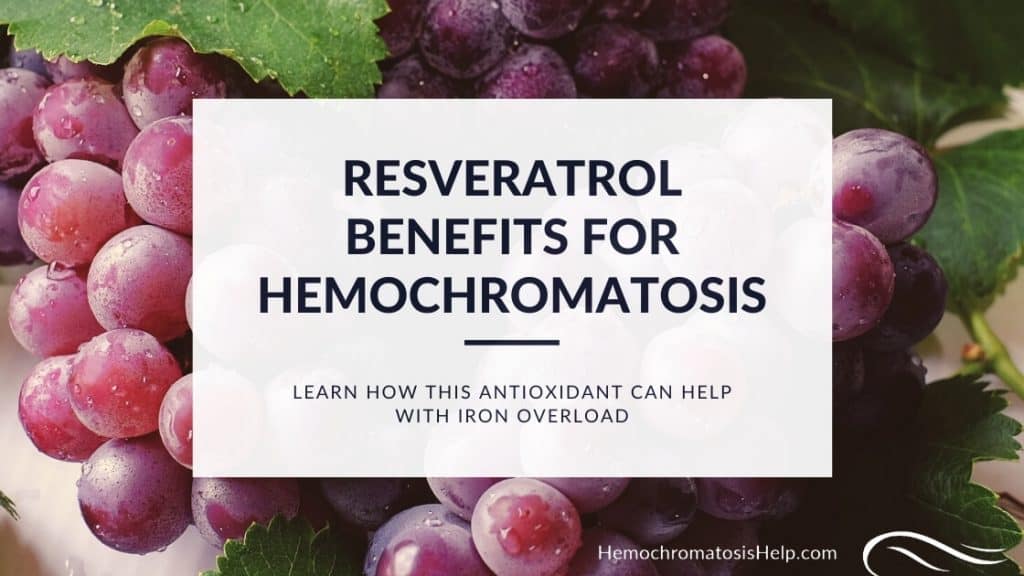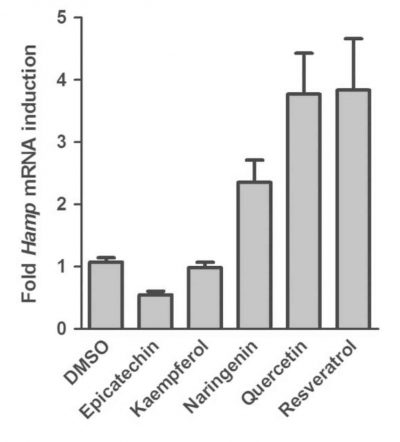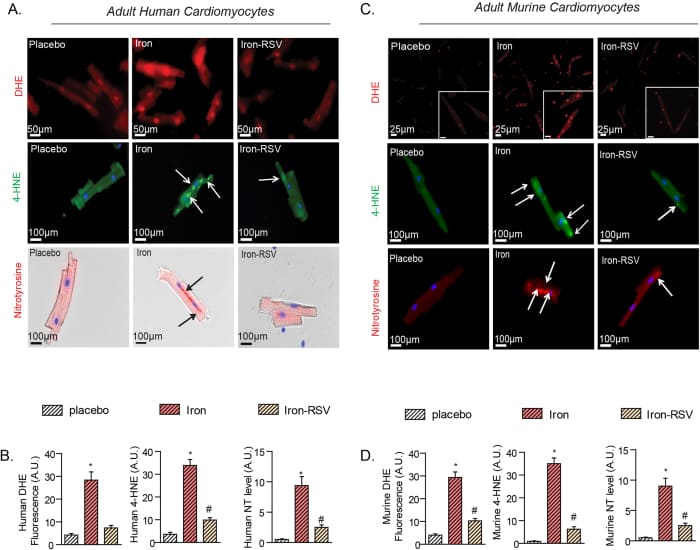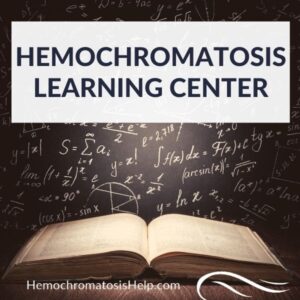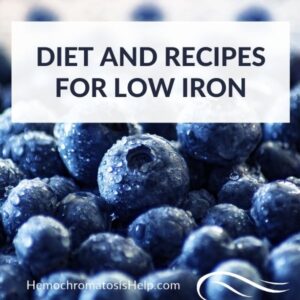Resveratrol may also be very important in iron overload.
An impressive list of research demonstrates resveratrol’s potential benefits to iron overload, including:
- As a powerful polyphenol, it blocks iron absorption from the diet.
- It may impact genetic expression to increase hepcidin (which results in lower iron).
- Resveratrol protects cells from damage due to excess iron, especially liver and heart cells.
- Finally, resveratrol is a powerful antioxidant and anti-inflammatory agent.
Read on as we discuss the research that has been done on this fascinating polyphenol to learn precisely how you can include it in your diet and supplement routine!
Resveratrol Blocks Iron Absorption From the Diet
As a polyphenol, it should not come as a surprise that resveratrol shares the same iron-blocking effects that other polyphenols do when consumed at the same time as an iron-rich meal.
The ability to bind to iron and inhibit its absorption is the most important characteristic of polyphenols to a person with hemochromatosis.
When taken orally (either as a supplement or in the diet), resveratrol may help reduce iron absorption from the diet. This puts it in the same camp as our other favorite iron blockers, including phytates, calcium, and the other polyphenols. (Reference)

FREE GUIDE: TOP 9 MISTAKES HEMOCHROMATOSIS PATIENTS MAKE
After working with hemochromatosis patients over the past 10 years we have seen these mistakes over and over again including:
- Why when your doctor says “phlebotomy is the only thing you can do” they may not be completely correct
- The real importance of diet and supplementation for those with hemochromatosis
- Why Googling about hemochromatosis is one of the last things we recommend
- And much more…
Resveratrol Reduces Iron by Raising Hepcidin Levels
Hepcidin is the primary hormone responsible for maintaining proper iron levels.
In hemochromatosis, hepcidin levels are low due to variations in the HFE gene, and as a result of low hepcidin, the body absorbs more iron.
Low hepcidin levels are one of the leading causes of high iron in someone with genetic hemochromatosis. If you could raise hepcidin levels in the body, less iron would be absorbed, resulting in less iron overload.
It seems that one of the ways resveratrol helps in iron overload is exactly this way, by raising hepcidin!
The way resveratrol does this may be related to how it impacts the genetic expression of a gene called HAMP.
When you stimulate a gene in the body, it may help that gene do more than it would have done if it hadn’t been stimulated in the first place.
HAMP is the gene in our bodies that naturally increases hepcidin levels. And when HAMP is stimulated, our bodies produce more hepcidin.
More HAMP activity → More hepcidin → Less iron absorption from the diet
One study published in Free Radical Biology & Medicine looked carefully at HAMP gene expression and found that resveratrol (and her synergistic polyphenolic partner, quercetin) both raise HAMP activity.
This study demonstrated that resveratrol raised hepcidin, a positive change for someone with iron overload!
Resveratrol: Protector of the Heart and Liver
The liver is the organ most often at risk in hemochromatosis. Excess iron in the liver can lead to many adverse effects, such as damage from oxidative stress and inflammation, fibrosis, and liver damage.
Fortunately, studies have shown resveratrol may be highly protective against liver injury.
One study looking at iron-overloaded mice with damaged livers caused by the excess iron found that resveratrol significantly improved the health of their livers. It seemed to do this by directly protecting the livers from damage caused by the iron:
Hepatic iron-overload was associated with hepatosplenomegaly, increased oxidative stress, hepatic fibrosis, and inflammation, and a pro-apoptotic state which was markedly corrected by resveratrol therapy . . . .
Importantly, resveratrol treatment did not affect the degree of hepatic iron-overload but rather direct protects the liver from iron-mediated injury. . . .
Our findings illustrate a novel and definitive therapeutic action of resveratrol and represent an economically feasible therapeutic intervention to treat hepatic iron-overload and liver disease.
-Liver Int. 2016 Feb;36(2):246-57. PubMed PMID: 26077449.
Similarly, resveratrol may also be protective to the heart and cardiovascular system that has been negatively affected by excess iron levels.
While the heart is not as commonly affected by high iron as the liver, some individuals may be susceptible to oxidative stress and fibrosis in the tissues of this most critical organ.
Another study looked at how high iron hurts the cells of the heart. It then added resveratrol to see if that made any difference to the iron-overloaded heart cells.
This research demonstrated that resveratrol significantly reduced high iron’s oxidative and fibrotic damage to the heart!
Here are some quotations taken from this study. We realize they are pretty dense and technical, so we’ll break it down and make sense of it below.
Iron-mediated pro-oxidant and pro-fibrotic effects in human and murine cardiomyocytes and cardiofibroblasts were suppressed by resveratrol which correlated with reduction in iron-induced myocardial oxidative stress and myocardial fibrosis. Resveratrol represents a clinically and economically feasible therapeutic intervention to reduce the global burden from iron-overload cardiomyopathy at early and chronic stages of iron-overload.
Notably, iron-induced oxidative stress in human cardiomyocytes and cardiofibroblasts was completely prevented by RSV directly supporting a possible therapeutic effect in patients with iron-overload. We showed that RSV therapy prevents and rescues the iron-induced pathological events including Ca2+ dysregulation, oxidative stress and myocardial fibrosis.
-Sci Rep. 2015 Dec 7;5:18132. PubMed PMID: 26638758
The essential finding from this study is that resveratrol may help prevent oxidative effects and cellular fibrosis in heart cells with iron overload.
The following graph from this study shows markers indicating cardiovascular damage due to iron overload and subsequent markers indicating strong protection from resveratrol:
These images above show iron causing damage to heart cells (“Cardiomyocytes”) and that resveratrol (“RSV”) significantly decreases the impact of that iron overload.
Images A and C are views of human and murine heart cells.
- The first column shows a baseline of normal cells.
- The second column shows cells containing iron.
- The third column shows the cells with both iron and resveratrol.
Images B and D are graphs demonstrating markers of oxidative stress and fibrosis.
- Gray represents the baseline with no iron (“placebo”).
- Red represents the cells exposed to just iron without resveratrol.
- Yellow represents the cells exposed to both iron and resveratrol.
When you compare these graphs, you’ll first notice that the levels of damage are notable in the red bar. But then notice the yellow bar. Yellow is a high-iron environment with protective resveratrol added.
Adding resveratrol to a heart cell with high iron takes the level of oxidative damage down to close to what the heart would be like without any high iron at all!
What’s the key takeaway from these studies?
Research has demonstrated a potentially positive impact of resveratrol upon iron overloaded cells in the heart and liver.
As these are two organs often damaged in hemochromatosis, these are exciting findings as a way to protect these vital organs when in a state of iron overload.
Resveratrol as a powerful antioxidant and anti-inflammatory agent
Finally, in addition to its list of potential benefits in iron overload, resveratrol is a well-renowned nutrient demonstrating a wide range of support to our overall health.
Resveratrol possesses potent anti-inflammatory and antioxidant effects and is known to positively modulate healthy gene expression, including the genes associated with longevity and a healthy life span (like the gene mentioned below, named SIRT1).
Dr. Rhonda Patrick, Ph.D., summarizes the benefits of resveratrol on overall health and aging well when she states:
Resveratrol elicits a broad range of physiological responses such as activating anti-inflammatory and antioxidant response pathways and promoting the activation of SIRT1. These responses have translated to functional health improvements and given resveratrol’s ability to activate cellular protective mechanisms, it has the potential to be used as a preventive supplement. (Reference)
How to use Resveratrol for Hemochromatosis
Resveratrol occurs in our diets in richly-colored berries, dark chocolate, and red wine. One of nature’s most powerful polyphenols is delicious to eat and an important part of any healthy diet.
However, it may be difficult to eat enough resveratrol to make a significant impact when it comes to challenging health concerns like iron overload.
As with many natural substances, ordinary dietary consumption of resveratrol is a fraction of what can be found in a supplement.
For example, one capsule of resveratrol may be equivalent to 60 glasses of red wine, but without the alcohol!
This is why many people choose to supplement their diet with a capsule form of resveratrol to ensure they are getting this vital nutrient in significant amounts regularly.
One final note to make is that resveratrol works best when paired with another powerful antioxidant polyphenol, quercetin!
Quercetin is a bioflavonoid antioxidant found in many nutrient-rich fruits and vegetables, especially high in red onions and apples. Studies have shown it may play an important role in fighting free-radical damage, reducing inflammation, combatting allergies, supporting heart health, and protecting liver health. And, Quercetin also has a lot of essential roles to play in iron overload, including being a natural iron chelator!
Resveratrol and Quercetin together possess a strong ability to protect cells from iron overload while simultaneously supporting overall health and well-being.
This is why we have paired these two together in our Hemochromatosis Help Quercetin and Resveratrol Complex.
Bayele HK, Balesaria S, Srai SK. Phytoestrogens modulate hepcidin expression by Nrf2: Implications for dietary control of iron absorption. Free Radic Biol Med. 2015 Dec;89:1192-202. doi:10.1016/j.freeradbiomed.2015.11.001. Epub 2015 Nov 10. PMID: 26546695.
Das SK, Wang W, Zhabyeyev P, Basu R, McLean B, Fan D, Parajuli N, DesAulniers J, Patel VB, Hajjar RJ, Dyck JR, Kassiri Z, Oudit GY. Iron-overload injury and cardiomyopathy in acquired and genetic models is attenuated by resveratrol therapy. Sci Rep. 2015 Dec 7;5:18132. doi: 10.1038/srep18132. PubMed PMID:26638758.
Das SK, DesAulniers J, Dyck JR, Kassiri Z, Oudit GY. Resveratrol mediates therapeutic hepatic effects in acquired and genetic murine models of iron-overload. Liver Int. 2016 Feb;36(2):246-57. doi: 10.1111/liv.12893. Epub
2015 Jul 3. PubMed PMID: 26077449.
Galtieri A, Tellone E, Ficarra S, et al. Resveratrol treatment induces redox stress in red blood cells: a possible role of caspase 3 in metabolism and anion transport. Biol Chem. 2010;391(9):1057‐1065. doi:10.1515/BC.2010.100 PMID: 20536388
Granzotto A, Zatta P. Resveratrol and Alzheimer’s disease: message in a bottle on red wine and cognition. Front Aging Neurosci. 2014 May 14;6:95. doi: 10.3389/fnagi.2014.00095. PMID: 24860502
Imam MU, Zhang S, Ma J, Wang H, Wang F. Antioxidants Mediate Both Iron Homeostasis and Oxidative Stress. Nutrients. 2017 Jun 28;9(7):671. doi: 10.3390/nu9070671. PMID: 28657578.
Kwon KJ, Kim JN, Kim MK, Lee J, Ignarro LJ, Kim HJ, Shin CY, Han SH. Melatonin synergistically increases resveratrol-induced heme oxygenase-1 expression through the inhibition of ubiquitin-dependent proteasome pathway: a possible role in neuroprotection. J Pineal Res. 2011 Mar;50(2):110-23. doi:10.1111/j.1600-079X.2010.00820.x. Epub 2010 Nov 15. PubMed PMID: 21073519.
Milman NT. Managing Genetic Hemochromatosis: An Overview of Dietary Measures, Which May Reduce Intestinal Iron Absorption in Persons With Iron Overload. Gastroenterology Res. 2021 Apr;14(2):66-80. doi: 10.14740/gr1366. Epub 2021 Apr 21. PMID: 34007348
Patrick Rhonda: https://www.foundmyfitness.com/topics/resveratrol
Wikipedia, “Heme Oxygenase”, https://en.wikipedia.org/wiki/Heme_oxygenase, Accessed December 2021.
Guo, Jialin, Yanan Li, Yanan Zhang, Yixuan Zhang, Zhaojun Meng, and Junqing Yuan. “Resveratrol Ameliorates Iron Overload Induced Liver Fibrosis in Mice by Regulating Iron Homeostasis.” Frontiers in Pharmacology 13 (2022): 923656. https://doi.org/10.3389/fphar.2022.923656.
Li, Jia, Yifei Wang, Li Wang, Yan Zhang, Xiaoli Liu, Yuxin Chen, and Xiaohong Liu. “The Protective Mechanism of Resveratrol Against Hepatic Injury Induced by Iron Overload in Mice.” Journal of Biochemical and Molecular Toxicology 35, no. 7 (2021): e22774. https://doi.org/10.1002/jbt.22774.
Aluwi, Norhafizah, Mohd Zaki Salleh, Nor Fadilah Rajab, Nurliyana Abdul Razak, and Syed Farid Syed Omar. “Deferiprone–Resveratrol Hybrid Attenuates Iron Accumulation, Oxidative Stress, and Antioxidant Defenses in Iron-Loaded Human Huh7 Hepatic Cells.” Antioxidants 13, no. 4 (2024): 373. https://doi.org/10.3390/antiox13040373.
Castel, Hélène, Romain Goffin, Sophie Corroyer, Laurent Belaud-Rotureau, Michel Narce, Philippe Savarin, Frédéric Moreau-Gaudry, et al. “Resveratrol Mediates Therapeutic Hepatic Effects in Acquired and Genetic Murine Models of Iron-Overload.” Haematologica 101, no. 12 (2016): e488–e491. https://doi.org/10.3324/haematol.2015.139654.
Goffin, Romain, Hélène Castel, Sophie Corroyer, Laurent Belaud-Rotureau, Michel Narce, Philippe Savarin, Frédéric Moreau-Gaudry, et al. “Iron-Overload Injury and Cardiomyopathy in Acquired and Genetic Models Is Attenuated by Resveratrol Therapy.” Free Radical Biology and Medicine 90 (2016): 194–204. https://doi.org/10.1016/j.freeradbiomed.2015.11.025.
Professional Quality Supplements Hand-Picked by the Naturopathic Doctors at Hemochromatosis Help.

